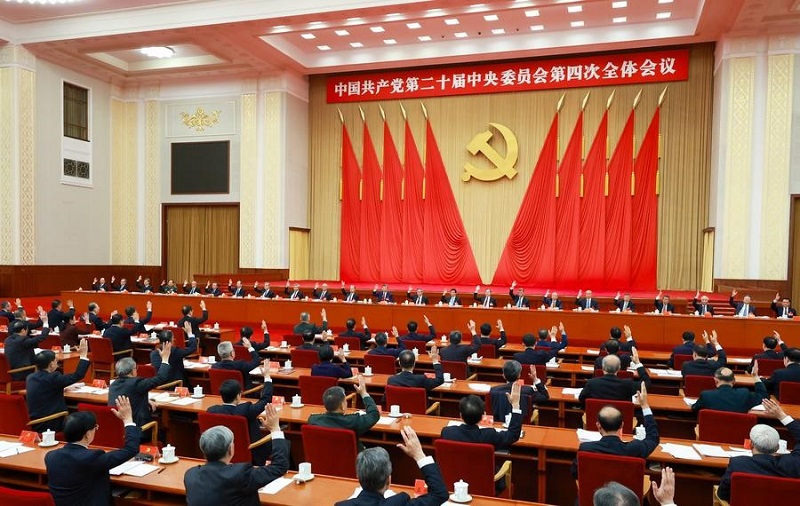In late October 2025, the fourth plenary session of the 20th Central Committee of the Communist Party of China (CPC) convened in Beijing. This pivotal meeting laid out the strategic blueprint for China’s development over the next five years, a defining phase for China to basically achieve socialist modernization by 2035. The plenum has drawn significant global attention, providing a key window into understanding China’s economic policies and development direction over the coming years, and their profound implications for the world.

The Political Bureau of the Communist Party of China (CPC) Central Committee presides over the fourth plenary session of the 20th CPC Central Committee in Beijing, capital of China. The 20th Central Committee of the CPC convened its fourth plenary session in Beijing from Monday to Thursday. (Xinhua/Ding Haitao)
The plenum set the following major objectives for the 15th Five-Year Plan (2026-2030) period: significant advancements in high-quality development and scientific and technological self-reliance; fresh breakthroughs in further deepening reform comprehensively; notable cultural and ethical progress across society; further improvements in the quality of life; major new strides in advancing the Beautiful China Initiative; and further advances in strengthening the national security shield.
Long-term planning provides the country with a central axis and direction for development. Through this mechanism, the Party’s governance vision and development concepts are translated into practical guides and action plans. As President Xi Jinping noted that scientifically formulating and consecutively implementing five-year plans is an important experience in the Party’s governance and a significant political advantage of socialism with Chinese characteristics. This insight captures the essence of China’s long-term development approach, which has ensured policy continuity and consistency.
More and more international observers have begun to realize the effectiveness of China’s planning system. Former Secretary General for Industry and Small and Medium Enterprises of Spain’s Ministry of Industry, Trade and Tourism María Callejón praised China’s long-term planning and effective execution at a recent forum on global governance organized by China Today in Barcelona in late September. She said that China has demonstrated foresight and effectiveness in addressing practical issues, such as those related to energy, security, and development. Callejón emphasized that China benefits from a unified leadership system and long-term planning, exemplified by its five-year plans, which provide clear development directions and goals supported by a robust implementation framework.
Despite turbulent global situations, China’s 14th Five-Year Plan period (2021-2025) has delivered remarkable achievements that have captured global attention. China’s economy demonstrated significant resilience. With the economic aggregate projected to reach about RMB 140 trillion in 2025, and the five-year economic increment set to surpass RMB 35 trillion, China’s average annual contribution to global economic growth will continue to hover around 30 percent, making it the most stable and reliable engine for the world economy. China has maintained its position as the top global producer and seller of new energy vehicles and the largest goods trader in the world, with an average annual trade growth of 8 percent.
The achievements extend beyond sheer growth metrics. China has reached new heights in innovation with major scientific breakthroughs and became the first country to surpass 4 million domestic valid invention patents.
China’s breakthroughs in artificial intelligence, quantum technology, crewed spaceflight, and deep-space exploration have resulted in it achieving multiple global “firsts.” In 2023, President Xi creatively introduced the concept of new quality productive forces that are characterized by innovation and high quality, with the focus on technological breakthroughs, advanced manufacturing, and high-tech industries. This innovative concept has provided an inspiring guide for China’s high-quality development.

This photo shows the production line of YADEA at the electric scooter industrial park in Xishan District, Wuxi, east China's Jiangsu Province, Sept. 16, 2025. (Xinhua/Liu Jiaqi)
The emergence of innovations like DeepSeek and humanoid robots, and the booming new energy vehicle industry, alongside advancements in biomanufacturing and quantum technology, illustrates the deep integration of scientific and industrial innovation, accelerating the formation of new quality productive forces. China’s global innovation index ranking rose to the 10th place by 2025, up from the 34th in 2012, making it one of the fastest-growing innovative economies globally.
This shift from a “world factory” to an “innovation powerhouse” has transformed China’s role in the global landscape, with multinationals increasingly viewing it as a global R&D hub.
According to the communique released by the CPC plenum on October 23, during the 15th Five-Year Plan period, China will continue to attach great importance on enhancing the national innovation system and comprehensively boosting the capacity for independent innovation, so as to unleash new quality productive forces. The plenum also called for strengthening original innovation and R&D in core technologies in key fields, fostering a comprehensive integration of scientific and technological innovation with industrial innovation, advancing the development of education, science and technology, and human resources in a holistic manner, and furthering the building of a digital China.
Meanwhile, the plenum also put store by building a modernized industrial system, reinforcing the foundations of the real economy, building a robust domestic market, and promoting high-standard opening-up, among many others.
China’s development is inextricably linked with the world. Despite headwinds against globalization and rising unilateralism and protectionism sentiments, China has unswervingly promoted high-standard opening up during the 14th Five-Year Plan period. Notable measures include the removal of foreign investment restrictions in the manufacturing sector and the orderly expansion of opening up pilots in the services sector. China has granted 100 percent zero-tariff treatment to all least developed countries and African nations with which it has established diplomatic relations. China is now a major trading partner for more than 150 countries and regions. By the end of 2024, more than 1.239 million foreign-invested enterprises had been established in China, with utilized foreign investment reaching RMB 20.6 trillion.
As Bernard Dewit, Chairman of the Belgian-Chinese Chamber of Commerce, observed, foreign enterprises benefit from operating in China, and Chinese enterprises “going global” positively impact host countries, demonstrating how China’s high-level opening up benefits the global economy.
In an era of profound global transformation, China’s long-term planning, with the strategic focus on high-quality growth and commitment to peaceful development and cooperation, provides a crucial anchor of stability. Its modernization journey – marked by historic economic achievements and improved public well-being – demonstrates an innovative model for solving humanity’s pressing challenges. By pursuing a modernization path tailored to its distinctive conditions, China affirms that there is a spectrum of viable development models, thus contributing to a more multipolar, equitable, and prosperous world.